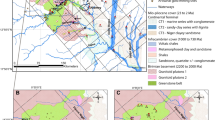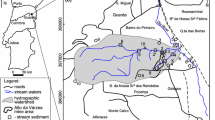Abstract
This study evaluated the impact of an abandoned Ag mine on the quality of surface and groundwater. The mining site of Huautla is in south Morelos State, central Mexico. Ag–Pb–Zn and Au–Cu sulfide ores were mined in the district. The ores were characterized by the presence of Ag, galena (PbS), sphalerite (ZnS), and stromeyerite (CuAgS). Ag was the metal of greater interest. Other metals included Cu, Pb, Zn, and Au. Mining activities stopped in the early 1990s when the market price of Ag decreased; the abandoned mines then were flooded by rising groundwater levels. Because of the urgent demand for water by the inhabitants in the area, this water has been used as drinking water and as waterholes for livestock. Water sampling points included abandoned mines (América, Pajáro, Santiago, Tlachichilpa, and San Francisco), dams, and dug wells. The greatest concentrations of As and other toxic chemical elements (Fe, Mn, Pb, Cd, F) were detected in groundwater samples from flooded mines. The presence of these elements was related to the rock–water interaction process. The oxidation of sulfides appears to be the cause of increased metal concentrations in groundwater samples from flooded mine. Other possible water–rock interaction processes that can control the presence of arsenic in groundwater were the adsorption of arsenic in iron oxyhydroxides, the adsorption in carbonates, and/or coprecipitation with calcite. In the case of the San Francisco and América mines, the oxidation conditions, low correlation of As with SO4 2− and Fe2+, and concentrations of silica indicate that the presence of As in the groundwater could be due also to competition for adsorption sites.








Similar content being viewed by others
References
Antunes IMHR, Albuquerque MTD (2013) Using indicator kriging for the evaluation of arsenic potential contamination in an abandoned mining area (Portugal). Sci Total Environ 442:545–552. doi:10.1016/j.scitotenv.2012.10.010
APHA, Awwa, WEF (2005) Standard methods for the examination of water and wastewater, 21st edn. APHA, AWWA, WEF, Washington, DC, p 1236
Appelo CAJ, Postma D (2005) Geochemistry, groundwater and pollution, 2nd edn. Balkema, Rotterdam, p 649
Armienta MA, Segovia N (2008) Arsenic and fluoride in the groundwater of Mexico. Environ Geochem Health 30:345–353. doi:10.1007/s10635-008-9167-8
Armienta MA, Villaseñor G, Rodriguez R, Ongley LK, Mango H (2001) The role of arsenic bearing rocks in the groundwater pollution at Zimapan Valley, Mexico. Environ Geol 4–5:571–581
Avilés M, Garrido SE, Esteller MV, De La Paz JS, Najera C, Cortés J (2013) Removal of groundwater arsenic using a household filter with iron spikes and stainless steel. J Environ Manag 131:103–109. doi:10.1016/j.jenvman.2013.09.037
Bhattacharya P, Jacks G, Ahmed KM, Routh J, Khan AA (2002) Arsenic in groundwater of the Bengal Delta Plain aquifers in Bangladesh. Bull Environ Contam Toxicol 69:538–545
Biswas A, Gustafsson JP, Neidhardt H, Halder D, Kundu AK, Chatterjee D, Berner Z, Bhattacharya P (2014) Role of competing ions in the mobilization of arsenic in groundwater of Bengal Basin: insight from surface complexation modeling. Water Res 55(15):30–39. doi:10.1016/j.watres.2014.02.00
Boulding JR, Ginn JS (2004) Practical handbook of soil, vadose zone, and ground-water contamination. Assessment, prevention, and remediation, 2nd edn. Lewis Pub, Boca Raton, p 691
Bundschuh J, Litter MI, Bhattacharya P (2012) Arsenic in Latin America, an unrevealed continent: occurrence, health effects and mitigation. Sci Total Environ 429:1–332. doi:10.1016/j.scitotenv.2012.04.047 (Special issue)
Buragohain M, Bhuyan B, Sarma HP (2010) Seasonal variation of lead, arsenic, cadmium and aluminium contamination of groundwater in Dhemaji district, Assam, India. Environ Monit Assess 170:345–351. doi:10.1007/s10661-009-1237-6
Carrillo A, Drever JI (1998) Adsorption of arsenic by natural aquifer material in the San Antonio-El Triunfoo mining area, Baja California, Mexico. Environ Geol 35(4):251–257
Carrillo-Chávez A, Drever JJ, Martínez M (2000) Arsenic content and groundwater geochemistry of San Antonio-El Triunfo, Carrizal and Los Planes aquifers in southernmost Baja California, Mexico. Environ Geol 39(11):1295–1303
Castro-Larragoitia J, Kramar U, Monroy-Fernández MG, Viera-Décida F, García-González EG (2013) Heavy metal and arsenic dispersion in a copper-skarn mining district in a Mexican semi-arid environment: sources, pathways and fate. Environ Earth Sci 69:1915–1929. doi:10.1007/s12665-012-2024-1
Chakraborti D, Rahman MM, Murrill M, Das R, Patil SSG, Sarkar A, Dadapeer HJ, Yendigeri S, Ahmed R, Das KK (2013) Environmental arsenic contamination and its health effects in a historic gold mining area of the Mangalur greenstone belt of Northeastern Karnataka, India. J Hazard Mater 262:1048–1055
DOF Diario Oficial de la Federación (2000) Modificación a la Norma Oficial Mexicana NOM 127-SSA1-1994. Salud Ambiental. Agua para uso y consumo humano. Límites permisibles de calidad y tratamientos a que debe someterse el agua para su potabilización. Secretaria de Salud. México. Diario Oficial de la Federación, 22 de noviembre de 2000
DOF Diario Oficial de la Federación (2005) Norma Oficial Mexicana. Salud Ambiental NOM 230-SSA1-2002. Agua para uso y consumo humano. Requisitos sanitarios que se deben cumplir en los sistemas de abastecimiento públicos y privados durante el manejo del agua. Procedimientos sanitarios para el muestreo. Secretaria de Salud. México. Diario Oficial de la Federación, 15 de julio de 2005
Flakova R, Zenisova Z, Sracek O, Krcmar D, Ondrejkova I, Chovan M, Lalinská B, Fendekova M (2012) The behavior of arsenic and antimony at Pezinok mining site, southwestern part of the Slovak Republic. Environ Earth Sci 66(4):1043–1057. doi:10.1007/s12665-011-1310-7
Gao X, Wang Y, Hy Q, Su C (2011) Effects of anion competitive adsorption on arsenic enrichment in groundwater. J Environ Sci Health Part A 46:471–479. doi:10.1080/10934529.2011.551726
Gemici Ü (2008) Evaluation of the water quality related to the acid mine drainage of an abandoned mercury mine (Alaşehir, Turkey). Environ Monit Assess 147:93–106. doi:10.1007/s10661-007-0101-9
Gutiérrez-Ojeda C (2009) Determining the origin of arsenic in the Lagunera region aquifer, Mexico using geochemical modeling. In: Bundschuh J, Armienta MA, Biskle P, Bhattacharya P, Matschullat J, Mukherjee AB (eds) Natural arsenic in groundwater of Latin America. CRC Press, Boca Raton, pp 163–170
Iskandar I, Koike K (2011) Distinguishing potential sources of arsenic release to groundwater around a fault zone containing a mine site. Environ Earth Sci 63:595–608. doi:10.1007/s12665-010-0727-8
Lee JY, Choi JC, Yi MJ, Kim JW, Cheon JY, Choi YK, Choi MJ, Lee KK (2005) Potential groundwater contamination with toxic metals in around an abandoned Zn mine, Korea. Water Air Soil Pollut 165:167–185
Martínez-Villegas N, Briones-Gallardo R, Ramos-Leal JA, Avalos-Borja M, Castañón-Sandoval AD, Razo-Flores E, Villalobos M (2013) Arsenic mobility controlled by solid calcium arsenates: a case study in Mexico showcasing a potentially widespread environmental problem. Environ Pollut 176:114–122. doi:10.1016/j.envpol.2012.12.025
Parkhurst DL Appelo CAJ (1999). User’s guide to PHREEQC (version 2)—a computer program for speciation, reaction-path, 1D-transport, and inverse geochemical calculations. US Geol Surv Water Resour Inv Rep 99-4259, p 312
Ramos OE, Rötting TS, French M, Sracek O, Bundschuh J, Quintanilla J, Bhattacharya P (2014) Geochemical processes controlling mobilization of arsenic and trace elements in shallow aquifers and surface waters in the Antequera and Poopó mining regions. Bolivian Altiplano. J Hydrol 518(Part C):421–433. doi:10.1007/s12665-011-1288-1
Rodriguez R, Ramos JA, Armienta MA (2004) Groundwater arsenic variations: the role of local geology and rainfall. Appl Geochem 19(2):245–250. doi:10.1016/j.apgeochem.2003.09.010
Rodríguez-Licea F, Sánchez-Montes de Oca R, Gamboa-Avitia A (1962) Estudio geológico – minero del Distrito de Huautla, Morelos. Archivo Técnico del Consejo de Recursos Minerales. Servicio Geológico Mexicano, México
Schulze JG (1959) Contribución al estudio petrológico y mineralógico económico del mineral de Huautla, Morelos. Archivo Técnico del Consejo de Recursos Minerales. Servicio Geológico Mexicano, México
SECOFI Secretaría de Comercio y Fomento Industrial (1998) Informe de la carta geológica-minera y geoquímica. Hoja de Cuernavaca E14-5. Secretaría de Comercio y Fomento Industrial. Consejo de Recursos Minerales- Coordinación General de Minería. Chilpancingo, México
SGM Servicio Geológico Minero (2008) Monografía geológico-minera del Estado de Morelos. Servicio Geológico Minero. Secretaría de Economía. Gobierno Federal, México
Smedley PL, Kinniburgh DG (2002) A review of the source, behaviour and distribution of arsenic in natural waters. Appl Geochem 17:517–568. doi:10.1016/S0883-2927(02)00018-5
Sracek O, Bhattacharya P, Jacks G, Gustafsson JP, Von Brömssen M (2004) Behavior of arsenic and geochemical modeling of arsenic enrichment in aqueous environments. Appl Geochem 19:169–180. doi:10.1016/j.apgeochem.2003.09.005
Vivona R, Preziosi E, Madé B, Giuliano G (2007) Occurrence of minor toxic elements in volcanic-sedimentary aquifers: a case study in central Italy. Hydrogeol J 15:1183–1196. doi:10.1007/s10040-007-0169-x
Waterloo Hydrogeologic Inc (1999) User’s manual. AquaChem (v 3.7)
WHO World Health Organization (2006) Guidelines for drinking water quality. World Health Organization, Genève
Wilkie JE, Heering JG (1996) Adsorption of arsenic onto hydrous ferric oxide: effects of adsorbate/adsorbent rations and co-occurring solutes. Colloids Surf A 107(20):97–110
Winkela LHE, Casentinia B, Bardellid F, Voegelina A, Nikolaidisd NP, Charlete L (2013) Speciation of arsenic in Greek travertines: co-precipitation of arsenate with calcite. Geochim Cosmochim Acta 106(1):99–110. doi:10.1016/j.gca.2012.11.049
Wurl J, Mendez-Rodriguez L, Acosta-Vargas B (2014) Arsenic content in groundwater from the southern part of the San Antonio-El Triunfo mining district, Baja California Sur, Mexico. J Hydrol 518:447–459. doi:10.1016/j.jhydrol.2014.05.009
Acknowledgments
This research was supported by Consejo Nacional de Ciencia y Tecnología de México (CONACYT, Project No. 47076). We appreciate comments by the anonymous reviewers, which helped to improve the manuscript.
Author information
Authors and Affiliations
Corresponding author
Rights and permissions
About this article
Cite this article
Esteller, M.V., Domínguez-Mariani, E., Garrido, S.E. et al. Groundwater pollution by arsenic and other toxic elements in an abandoned silver mine, Mexico. Environ Earth Sci 74, 2893–2906 (2015). https://doi.org/10.1007/s12665-015-4315-9
Received:
Accepted:
Published:
Issue Date:
DOI: https://doi.org/10.1007/s12665-015-4315-9




